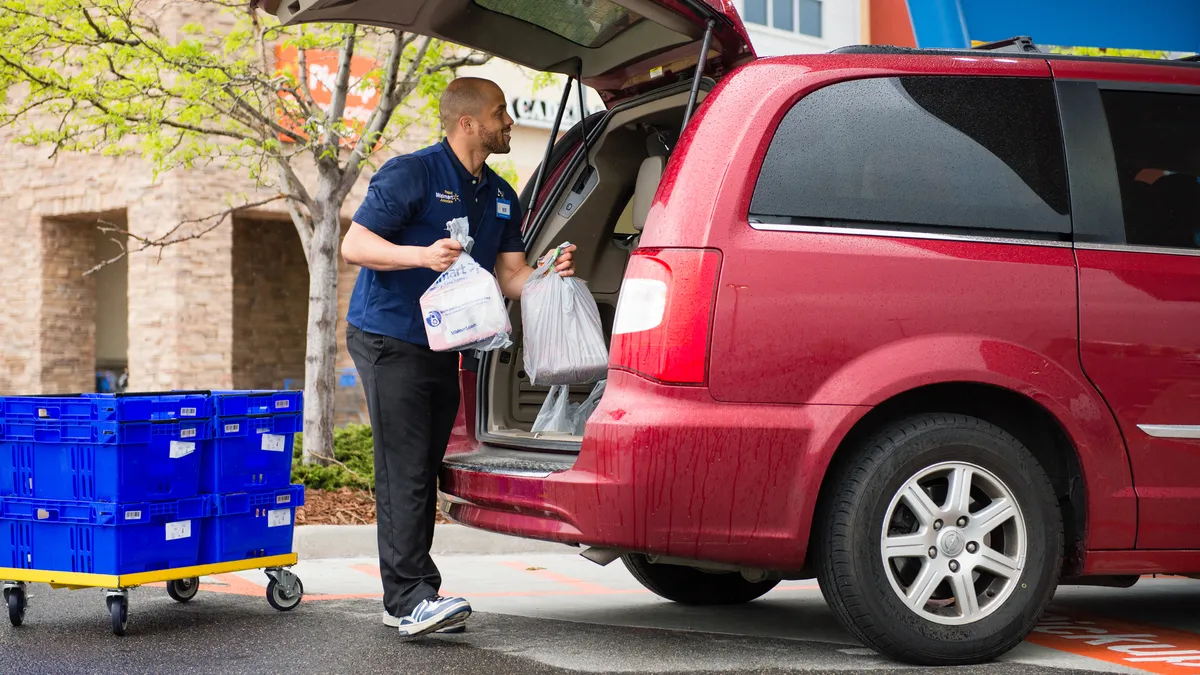Dive Brief:
- A report by Packaged Facts found that Walmart’s pickup strategy has surpassed competition, largely driven by its combination of curbside pickup and towers. Among click-and-collect consumers, about 42% identified Walmart as the pickup location for their last order — three times the amount that cited Target, which came in second.
- Half of all shoppers who used Walmart's click-and-collect service shopped at the store and bought additional items, the study found. Just 31% of people using the service at Target did, and just over a third of people using click-and-collect anywhere do, the study found.
- Walmart has made aggressive moves into e-commerce that are starting to pay off. The study found 78% of adults made a purchase from Walmart in the previous three months, with 75% coming in-store. However, 27% did order online — though only 5% of them purchased groceries.
Dive Insight:
With more than 40% of click-and-collect consumers choosing Walmart — compared to single digit percentages for most other stores like Best Buy and Home Depot — the trend seems confined almost exclusively to major retailers with a wide variety of products.
But with the lowest rate of click-and-collect purchases coming from food and groceries at 7.8%, it also indicates a major opportunity for grocers, including Walmart, to grow their click-and-collect channel, especially as younger shoppers increasingly prefer omnichannel options.
The benefits of having a seamless click-and-collect presence extend beyond providing consumers with convenience. According to the Packaged Facts report, 34% of click-and-collect consumers added to their baskets when they were on site for their order pick up, while another 16% entered the store but didn’t buy anything. Having a physical location plays a significant role in the omnichannel purchasing experience. It provides a major advantage for Walmart — and perhaps eventually Target — over e-commerce leader Amazon if the brick-and-mortar retailers continue to focus on that business while accelerating their ecommerce channels. Having a balance with brick-and-mortar can also help build loyalty for customers with additional and often spontaneous needs.
While in-store is still relevant to consumers across generations, younger consumers continue to drive online purchases — 47% of 25-to-34-year-old consumers have purchased online within the past month, versus 30% of boomer consumers. Younger consumers also purchase online more frequently, keeping the strong trajectory of e-commerce going as these consumers gain more spending power. Packaged Facts research shows the omnichannel ecommerce grew at 10% annually from 2011 to 2017, compared to 17% for internet-only retailers. It is expected that Amazon’s sales will continue to grow at a much faster rate than its competitors, and could then surpass Walmart in 2022 as the largest retailer in the U.S.
Walmart likely won’t relinquish the title without a fight, as the past three months of activity shows. While general merchandise gets the most click-and-collect purchases, food products represent just 5%. Walmart can lift its sales — and maintain its grocery edge over Amazon — by leveraging its popular private label products, like offering click-and-collect promotions that specifically focus on these lines. About 80% of Walmart customers have purchased at least one of seven private label brands from the retailer in the past quarter, which bodes well for the retailer as more consumers seek private label.
Walmart will also remain competitive as it increases the number of products it sells online — now at 75 million SKUs, according to the report — and by having a location within 10 miles of 90% of American consumers, most of whom still prefer to shop in store.






